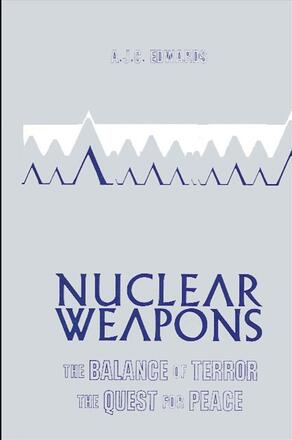List of Tables, Figures, and Appendix Figures
List of Abbreviations
Preface
1 The Balance of Terror
2 Basic Theory and the Evolution of Strategic Postures
Introduction
Basic Theory
Comparison with Earlier Balances of Power
Unilateral Terror
The Balance of Terror
Mutual Assured Destruction
Flexible Response
Subsequent Developments
Soviet Postures
3 How It Came To Be
Introduction
Birth of Nuclear Age
Political Tensions
The Balance of Terror
Conclusion
4 Is It Necessary?
Inroduction
Western Perceptions of the Soviet Threat
Words
Deeds
Soviet Perceptions of the Western Threat
Conclusion
5 Nuclear Weapons and World Politics
Introduction
Military Strength and Political Power
Limitations on Political Power of Strong Countries
Will-power of Weaker Countries
Will-power of Strong Countries
Perceptions and Signals
Conventional Capabilities World-wide
Other Nuclear Countries
Relative Military Strengths
Attitudes to Use of Military Force
Taunting Goliath
Global Political Effects
Bipolarity
The Status quo and Spheres of Influence
Conventions of International Behaviour
The Incentive to Bargain and Détente
Conclusion
6 Intrinsic Stability
Intrinsic and Dynamic Stability
Preliminary Exposition
Risk-aversion and Unacceptable Damage
Perceived Will to Retaliate
Intelligence
Communications
7 Military Capabilities
First and Second Strikes, Counter-force and Counter-city
Second-strike Capability to Inflict Unacceptable Damage
Alternative Formulations
First-striker's Advantage and the Incentive to Strike First
Counter-force Exchange Rates
The Development of Counter-force Capabilities
Ways of Reducing First-striker's Advantage
Launch on Assessment
Counter-city Second-strike Capabilities and the 'Strike and Bargain' Scenario
First-striker's Advantage and Deterrence against Conventional Attack
Vulnerability of Cities
Conclusions
8 War-fighting and Minimum Deterrence
Deterrence and War-fighting Capability
Other Needs for a War-fighting Capability
Some Elements in a War-fighting Capability
Civil Defence and War-fighting Capability
Minimum Deterrence and 'Sufficiency'
9 Arms Control
Shared Interests
Agreements
Objectives
Problems
SALT and MBFR
START, INF and the Geneva Negotiations
Mutual and Stable Minimum Deterrence (MSMD)
10 Dynamic Stability
Introduction
Full-scale Attack Scenario
Tension and Provocation Scenarios
Proliferation, Accident and Madness Scenarios
Misunderstanding
Escalation and the Boundaries of Crisis
Factors Affecting Escalation
Crisis Management
11 Extended Deterrence and First Nuclear Use
Introduction
Extended Deterrence
First Nuclear Use
Credibility
Role of Theatre Nuclear Weapons
Theatre Nuclear Weapons and Deterrence against Conventional Attack
Theatre Nuclear Weapons and Deterrence against Theatre Nuclear Attack
Stopping a War Once Begun
Fighting the War and Keeping it Limited
Flexibility
Circumstances of First Nuclear Use
Intermediate-range Theatre Nuclear Forces
Objections to Intermediate-range Nuclear Forces Modernisation
The 'Zero Option'
United States or NATO Deployments
12 Limiting Nuclear War
Could Nuclear Conflict be Limited?
Firebreak Visibility
Firebreaks by Announcement
Firebreaks and Flexibility of Weapon Systems
Firebreaks and Political Will
General Conclusions
Implications for NATO Strategy
13 Policies Towards the Blance of Terror: (1)Rejection and Abdication
Introduction
Need for a Balance of Terror
Advantages of a Balance of Terror
Disadvantages of a Balance of Terror
Alternative Policies
General and Complete Disarmament by Agreement
Unilateral Complete Disarmament
Nuclear Disarmament by Agreement
Unilateral Nuclear Disarmament
The Moral Dimension
Forswearing Aggression in Any Form
Forswearing First Nuclear Use
European Options
A European Nuclear-free Zone
Unilateral Withdrawal of Nuclear Forces from West European Soil
Independent Nuclear Deterrents
Conclusion
14 Policies Towards the Balance of Terror: (2) Acceptance and Improvement
Introduction
Reasons for Guarded Optimism
Main Threats to Stability
Hardening of Soviet Policies
Political Problems in the West
Political Turbulence World-wide
First-striker's Advantage
Hazards of Crisis
Combinations of Unstable Factors
Postscript on Nuclear Proliferation
Postscript on Defences against Nuclear Weapons
Some Policy Implications
Strategic Postures
Political Signals and Détente
Military Capabilities
Adequacy of Existing Capabilities
Appendix: The Algebra of Mutual Deterrence and Stability
A Simple Model
Functional Forms
Risk-aversion and the Will to Retaliate
Ability to Inflict Unacceptable Damage
War-fighting Capability
First-Striker's Advantage
Balance of Risk between Striking and Not Striking
Deterrence against Conventional Attack
Notes and References
Index
